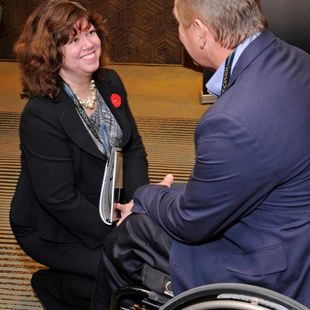


Lorin MacDonald's work was inspired by Rick Hansen's achievements.

The Reality of IDEA Must Include Accessibility
Nominated for the fourth consecutive year as Canadian Lawyer Magazine’s Top 25 Most Influential in the Human Rights category, Lorin MacDonald is one of Canada’s leading voices on disability issues. Over the last 30 years, Lorin has demonstrated her leadership, passion, and commitment to accessibility and inclusion in various volunteer and professional activities, all informed by her lived experience as a woman born with profound hearing loss.
“I never fight just for me. I fight to set a precedent so that others don’t have to go through them [barriers] again. It’s never easy being a pioneer because there’s a reason why it hasn’t been done. It takes a great deal of tenacity, commitment, and articulation.” But Lorin says, “I persist because of my unshakeable belief that Canadians living with disabilities deserve more.”
DiversiPro proudly presents our recent conversation with Lorin MacDonald, Founder and Principal of HearVue Inc., award-winning human rights lawyer, accessibility and disability subject matter expert, and inclusion champion.
A Conversation with Lorin Macdonald
Why is National AccessAbility Week significant in Canadian society and culture? And how is this significance reflected in your journey?
Nearly a quarter of Canada’s population identifies as living with one or more disabilities – over 6 million people! When you add the broader network of family, friends, co-workers, and community, it is fair to say that disability impacts half of Canadians. National AccessAbility Week is an opportunity to raise awareness of the critical need for accessibility and inclusion in our communities and workplaces. It was formerly known as National Access Awareness Week (NAAW) and was inspired by Rick Hansen’s Man in Motion Tour, which unfolded from 1985 to 1987. I saw Rick roll through my community in 1986, and I was awed by the impact one man could have. In 1994, I served as Ontario Chair of NAAW. In 2012, I had the opportunity to meet Rick and tell him how much he inspired me to do my part to do my part to increase accessibility.
This year’s commemoration runs from May 28 to June 3. Its purpose is three-fold: to celebrate the valuable contributions of Canadians with disabilities; to highlight the work of people, organizations and communities that are removing barriers; and to inspire reflection on ongoing efforts to become a more accessible and inclusive country.
What are the moral/constitutional/legal/ and pragmatic bases for promoting accessibility
as a worthwhile goal?
Morally, inclusion is the right thing to do. We all benefit when everyone can participate in society. Legally, we enshrine protection from disability discrimination in the Canadian Charter of Rights and Freedoms and the Canadian Human Rights Act. Given the greying of our population and how disability can strike us at any time, it makes sense to look at practices from a universal design lens rather than an accessibility lens. Consider the various developments explicitly intended for people with disabilities that benefit everyone. Curb cuts, automatic door openers, and increased auto-generated captioning on virtual platforms are a few examples.
the more layers there are to our identity, the more oppression we experience
You recently were part of a webinar titled Best Practices for Organizations to Create Inclusive Workplaces for People with Disabilities. How does Accessibility fit into the current social, political and economic imperative to establish Inclusion, Diversity, Equity and Anti-Racism (IDEA) as fundamental characteristics of Canadian workplaces?
Equity, Diversity and Inclusion (EDI) or IDEA conversations often fail to include Accessibility. If you do not intend to include, you will unintentionally exclude. Numerous reports over the past decade demonstrate that accessible workplaces and practices are good for business. Another critical aspect of IDEA conversations is the concept of intersectionality—the interconnection of social categorizations such as race, gender, and disability. We are not one identity – the more layers there are to our identity, the more oppression we experience. So, yes, accessibility is important, but it must take into consideration other categorizations and the impact on disability.
What impact does the lack of accessibility have on the day-to-day lives of Canadians?
Inaccessibility excludes, intentionally or unintentionally, counter to our vision of an equitable society as expressed in human rights legislation. On the other hand, the contribution of diverse voices allows for innovative approaches to longstanding challenges and the ability to address current and future opportunities.
How steadily has accessibility progressed as a societal goal over the last 50 years?
A clear understanding of history is important before things can change. Significant developments have occurred within the past 50 years, but progress has been slow. For example, the Ontario Government also closed institutions for people with developmental disabilities, moving to community-based services. As well, numerous grassroots disability groups were formed, such as the Canadian National Institute for the Blind (CNIB) and the Canadian Association for Community Living (now called Inclusion Canada). We also saw protections for people with disabilities in the Charter and the Canadian Human Rights Act and the rise of critical disability studies changing the narrative. Finally, in 2005, Ontario’s Accessibility for Ontarians with Disabilities Act paved the way for other provinces to create accessibility legislation, and The Accessible Canada Act was enacted in 2019.
it is fair to say that disability impacts half of Canadians
Where is the current frontline in the struggle for Accessibility?
Accessibility legislation has increased disability awareness. However, many significant barriers persist. It is troubling that over half of federal, provincial/territorial human rights commissions and tribunals applications are based on disability discrimination. Disability legislation is only as strong as its enforcement mechanisms. Unfortunately, as we have seen with the Access for Ontarians with Disabilities Act (AODA), this is sadly lacking. Healthcare policies continue to prioritize those with “quick-fix” medical conditions. Ableism was demonstrated when COVID created the need for remote work policies for most workers, which were activated at lightning speed, ignoring the decades-long pleas from employees with disabilities for the same flexibility.
In addition, people with disabilities are vastly unemployed or underemployed, living in grinding poverty. Disability poverty needs to be addressed and alleviated; hopefully, the proposed Canada Disability Benefit will become law very soon. However, until we meet the necessities of life for the 41% of Canadians with disabilities living below the poverty line, any other efforts won’t matter.
